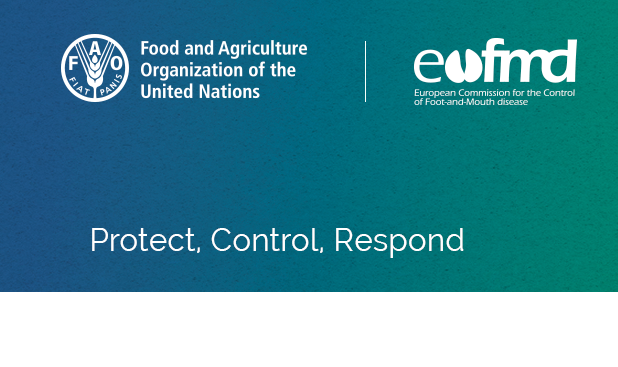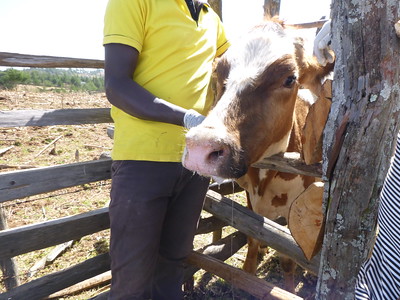Study an Open-Access Online Course
EuFMD's open-access online courses provide self-paced training which you may study anytime, anywhere, free of charge.
To study a course, click the links below. If you do not have a user account yet with EuFMD Virtual Learning, you will be asked to create one before starting the course.
EuFMD Virtual Learning also hosts a wide range of more detailed, tutored virtual learning courses. To find out more about how to participate in tutored online courses, please visit our website or contact us at EuFMD-Admin@fao.org.
Available courses:

Ask the Experts webinars 2025
Click here to accessThe EuFMD has held a number of events covering Foot-and-mouth disease and lumpy skin disease as “Ask the Experts” interactive webinar. This page provides access to the recordings of the sessions.
These one-hour webinars provide an overview about a range a topics that help you enhance your skills in Foot-and-Mouth Disease and lumpy skin disease preparedness, including biosecurity, outbreak investigation, surveillance, vaccination and post-vaccination.

Introduction to Foot-and-Mouth Disease
Enrol in the courseEinführung in die Maul- und Klauenseuche
Für den Kurs einschreibenIntroduction à la fièvre aphteuse
S'inscrire au coursThis course introduces foot-and-mouth disease (FMD), its importance, diagnosis, outbreak investigation and the control measures that might apply in a previously free country experiencing an outbreak.
The course consists of six modules. Upon completion of the modules and the course assessment, you will be able to download your certificate.
Who is the course for?
This course is suitable for all of those with an interest in FMD control. No prior knowledge of FMD is required.
Time required: 2.5 hours
The Introduction to Foot-and-Mouth Disease online training course is also available on the FAO elearning Academy and successful completion will give you a digital badge.

Introduction to Lumpy Skin Disease
Enrol in the courseIntroduction à la dermatose nodulaire contagieuse
S'inscrire au coursThis short module introduces lumpy skin disease, its distribution, impacts, aetiology, diagnosis epidemiology and control options. After studying the module, you should complete the course assessment, after which you will be able to download your certificate.
The module is intended as a "taster" and is taken from a longer course, the LSD Preparation Course, which is organised periodically.
Who is the course for?
This course is suitable for all of those with an interest in LSD, in affected countries or those at-risk.

Introduction to Rift Valley Fever
Enrol in the courseIntroduction à la Fièvre de la Vallée du Rift (FVR)
S'inscrire au coursThis course introduces the diagnosis, prevention and control of RVF, and is suitable for those based in countries that are either endemic or at-risk. The course is designed to be easy to study on a smartphone.
The course consists of fourteen modules, each of which should take you approximately 10 minutes to complete. After studying the modules, you should complete the course assessment, after which you will be able to download your certificate.
Who is the course for?
This course is suitable for anybody who would like to know more about RVF. It will be of particular interest to field veterinarians (public and private) and veterinary paraprofesssions who are working in countries that are either endemic or at high risk of RVF. No prior knowledge of RVF is required.

Introduction to sheep pox and goat pox
Enrol in the courseThis short, open-access and self-directed course aims to provide an overview of sheep pox and goat pox, recognise or suspect the disease in the field, identify the correct samples to collect and the relevant control measures.
Time required: One hour

Public Private Partnerships in the Veterinary Domain
This online course has been developed under a partnership between EuFMD and the WOAH and is accessed on the WOAH e-learning platform. The course introduces the potential for partnership between public and private sectors in the delivery of veterinary services and discusses the typology and implementation of such partnerships.
Who is the course for?
Time required: One hour

What is the Progressive Control Pathway?
This short e-learning module provides an overview of the Progressive Control Pathway for Foot-and-Mouth Disease (PCP-FMD), the tool used to FMD control under the GF-TADs Global Strategy.
Who is the course for?This course is suitable for all of those with an interest in FMD control in countries which are not free of the disease, and is a good introduction for those new to the PCP-FMD.
Time required: One hour

Introduction to the Risk Assessment Plan
Enrol in the courseIntroduction au plan d'évaluation des risques
S'inscrire au coursThis course is part of a series of self-directed online courses that aim to support progress on the Progressive Control Pathway for Foot-and-Mouth Disease (PCP-FMD).
The Risk Assessment Plan describes how the country intends to embark on the PCP-FMD and gain an understanding of the epidemiology of FMD in the country. Ultimately, the country will use that knowledge to develop a risk-based plan to reduce the impact of FMD (Risk-Based Strategic Plan). Completion of the RAP is the indicator outcome for entry into PCP-FMD Stage 1, as defined in the PCP-FMD guidelines.
The course consists of five self-directed online modules. These modules describe the purpose of the RAP, give guidance on how to develop a RAP and explain they key content that should be included within each chapter of the RAP document.
Who is the course for?
This course will be of interest to anyone who is involved in control of FMD in countries which are not currently free of the disease. It is particularly aimed at veterinarians who are working with countries in PCP-FMD Stage Zero and beginning the process of developing a RAP.
Time required: Four hours

Introduction to the Risk-Based Strategic Plan
This course introduces the Risk-Based Strategic Plan (RBSP). The RBSP describes how a country will reduce the impact of FMD in at least one husbandry sector or geographical area. The RBSP applies the outputs and knowledge gained through the implementation of the activities in PCP-FMD Stage One. An accepted RBSP is required for countries to be recognized as in PCP-FMD Stage Two.
The course consists of six self-directed online modules. These modules describe the purpose of the RBSP, give guidance on how to develop a risk-based control strategy and explain they key content that should be included within each chapter of the RBSP document.
Who is the course for?
This course will be of interest to anyone who is involved in control of FMD in countries which are not currently free of the disease. It is particularly aimed at veterinarians who are working with countries in PCP-FMD Stage One, and beginning the process of developing an RBSP.

Introduction to the Official Control Programme
This course is part of a series of self-directed online courses that aim to support progress on the Progressive Control Pathway for Foot-and-Mouth Disease (PCP-FMD).
The OCP describes how the country will eliminate virus circulation of FMD in at least one zone of the country, to mitigate the risks of FMD to the point where an application to WOAH for official recognition of freedom from FMD may be successful and suitable. Completion of the OCP is the indicator outcome for entry into PCP-FMD Stage 3, as defined in the PCP-FMD guidelines.
The course consists of six self-directed online modules. These modules describe the purpose of the OCP, give guidance on how to develop an OCP and explain they key content that should be included within each chapter of the OCP document.
Who is the course for?
This course will be of interest to anyone who is involved in control of FMD in countries which are not currently free of the disease. It is particularly aimed at veterinarians who are working with countries in PCP-FMD Stage Two and beginning the process of developing an OCP.
Time required: Four hours

ما هو مسار المكافحة التدريجية لمرض الحمى القلاعية؟
إن وحدة التعليم الإلكتروني القصيرة هذه باللغة العربية تمدك بنظرة عامة عن مسار المكافحة التدريجي لمرض الحمى القلاعية (PCP-FMD) ، حيث أنه الأداة المستخدمة للسيطرة على مرض الحمى القلاعية من خلال الإطار العالمى لمكافحة الأمراض العابرة للحدود GF_TAD بالإستراتيجية العالمية لمكافحة مرض الحمى القلاعية .
من هم المعنيون بهذه الدورة التدريبية؟
هذه الدورة التدريبية تناسب الذين يهتمون بمكافحة مرض الحمى القلاعية فى البلدان التى يستوطن بها المرض وايضا هولاء الذين هم حديثى التعرف بالمسار التدريجي لمكافحة مرض الحمى القلاعية.
الوقت اللازم : ساعة واحدة

Simulation Exercises for Animal Disease Emergencies
The Simulation Exercise for Animal Disease Emergencies online training course is on the FAO elearning Academy. It introduces simulation exercises as part of preparedness for animal disease emergencies and explains the processes involved in planning, conducting and evaluating simulation exercises. It also describes the various tools, approaches and strategies to support decision-making, as well as the different phases of an exercise.
Who is the course for?
This course is designed for a range of stakeholders with an interest in learning about animal health emergency preparedness and planning, including:
- Contingency planners.
- Risk managers and risk communication officers.
- Official veterinary staff and veterinarians.
- Emergency services and municipal representatives.
Time required: Three and a half hours

Introduction to the FMD Minimum Biorisk Management Standards
This course aims to provide an overview of the Minimum Biorisk Management Standards for foot-and-mouth disease laboratories (MBRMS), explaining the scope and the risks associated with the standards.
This course is directed to National Competent Authorities, Institute directors for FMD facilities and biorisk managers in FMD free countries in the European region to ensure they are aware of the importance and implications of their role in ensuring that laboratories handling infectious FMD virus (Tier D) and performing FMD diagnostic tests without handling infectious FMD virus (Tier C) adhere to the FMD Minimum Biorisk Management Standards.
This course consists of five modules . At the end of the course, you must complete an assessment to receive a certificate.
Time required: Two hours

Introduction to Animal Health Surveillance
This short, open access and self-directed course aims to provide an overview of the importance and key activities of animal health surveillance. It also forms the basis for further, in-depth courses on passive surveillance.
Time required: One hour

Introduction to the socioeconomics of foot-and-mouth and similar transboundary (FAST) animal diseases
This course aims to introduce non-expert learners to the fundamental concepts required to understand the socioeconomic analysis of animal disease. It also forms the basis for further, in-depth training on socioeconomic impact assessment and practical cost-benefit analysis of FMD and similar transboundary animal diseases.
Time required: One hour and a half